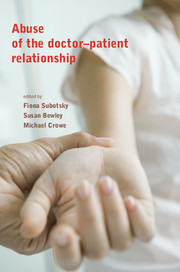Book contents
- Frontmatter
- Contents
- List of figures, tables and boxes
- List of contributors
- Foreword
- Introduction: mapping the territory
- 1 The ethical importance of boundaries to intimacy
- 2 The patient's perspective: impact and treatment
- 3 Teaching ethics and ethical behaviour to medical students
- 4 With the benefit of hindsight: lessons from history
- 5 The prevalence of boundary violations between mental health professionals and their clients
- 6 Psychiatry: responding to the Kerr/Haslam Inquiry
- 7 The general practitioner and abuse in primary care
- 8 Boundaries and boundary violations in psychotherapy
- 9 Sexual therapies: ethical guidelines, vulnerabilities and boundaries
- 10 Obstetrics and gynaecology: a special case?
- 11 Nurses as abusers: a career perspective
- 12 Medical management: governance and sexual boundary issues
- 13 Dealing with offending doctors: sanctions and remediation
- 14 Defending doctors: the protection society's experience
- 15 Regulation and its capacity to minimise abuse by professionals
- 16 The role of the General Medical Council
- Appendix 1 Extract from Vulnerable Patients, Safe Doctors
- Appendix 2 Codes of ethics of psychiatric associations in other countries
- Appendix 3 Guidance from the Council for Healthcare Regulatory Excellence
- Appendix 4 Examples of determinations by the General Medical Council's Fitness to Practise panels
- Appendix 5 Website resources and information
- Index
- Plate section
Appendix 1 - Extract from Vulnerable Patients, Safe Doctors
Published online by Cambridge University Press: 02 January 2018
- Frontmatter
- Contents
- List of figures, tables and boxes
- List of contributors
- Foreword
- Introduction: mapping the territory
- 1 The ethical importance of boundaries to intimacy
- 2 The patient's perspective: impact and treatment
- 3 Teaching ethics and ethical behaviour to medical students
- 4 With the benefit of hindsight: lessons from history
- 5 The prevalence of boundary violations between mental health professionals and their clients
- 6 Psychiatry: responding to the Kerr/Haslam Inquiry
- 7 The general practitioner and abuse in primary care
- 8 Boundaries and boundary violations in psychotherapy
- 9 Sexual therapies: ethical guidelines, vulnerabilities and boundaries
- 10 Obstetrics and gynaecology: a special case?
- 11 Nurses as abusers: a career perspective
- 12 Medical management: governance and sexual boundary issues
- 13 Dealing with offending doctors: sanctions and remediation
- 14 Defending doctors: the protection society's experience
- 15 Regulation and its capacity to minimise abuse by professionals
- 16 The role of the General Medical Council
- Appendix 1 Extract from Vulnerable Patients, Safe Doctors
- Appendix 2 Codes of ethics of psychiatric associations in other countries
- Appendix 3 Guidance from the Council for Healthcare Regulatory Excellence
- Appendix 4 Examples of determinations by the General Medical Council's Fitness to Practise panels
- Appendix 5 Website resources and information
- Index
- Plate section
Summary
The following is taken from Vulnerable Patients, Safe Doctors: Good Practice in Our Clinical Relationships (Royal College of Psychiatrists, College Report CR146, 2007). Although the boundaries of the psychiatric encounter are described below, the principles hold for boundaries of all doctor–patient encounters and similarly for the avoidance of boundary violations.
Boundaries of the psychiatric encounter
A number of features help to provide the boundaries of the psychiatric professional encounter, all of which are the responsibility of the psychiatrist. These include:
• setting (hospital, clinic, care home or family home)
• time (usually within agreed service hours)
• duration (agreed and consistently maintained)
• use of appropriate professional language
• appropriate professional dress and insignia
• limited and socially sanctioned physical touch
• the patient's mental health needs, not social or sexual needs, being taken as paramount.
There is clear evidence that even minor violations of these boundaries may be damaging to patients. Some are unacceptable in any circumstances, while others are not always clearly harmful to patients. Even those not unequivocally harmful should raise questions for the doctor or patient about their appropriateness, but may not be finally judged except in their detailed context.
The commonest boundary violations are non-sexual, and include inappropriate self-disclosure, involving the patient in a dual role (e.g. employing a patient or a patient's relative), speaking aggressively or rudely to patients and financial exploitation. Sexual violations are less common, but often start with apparently minor boundary violations, such as unjustifiably prolonged sessions, appointments out of working hours, treatment outside the normal place of work, except where clinically justified, and (in private practice) not charging a fee. Sexual boundary violations between psychiatrists and their patients usually take place in the context of a ‘special relationship’, to which the patient ‘assents’ rather than consents; they usually come to light when the relationship ends and the patient then reports the unprofessional relationship. The General Medical Council sees sexual boundary violations by doctors as serious professional misconduct and will normally remove the doctor from the medical register.
- Type
- Chapter
- Information
- Abuse of the Doctor-Patient Relationship , pp. 203 - 205Publisher: Royal College of PsychiatristsPrint publication year: 2010

